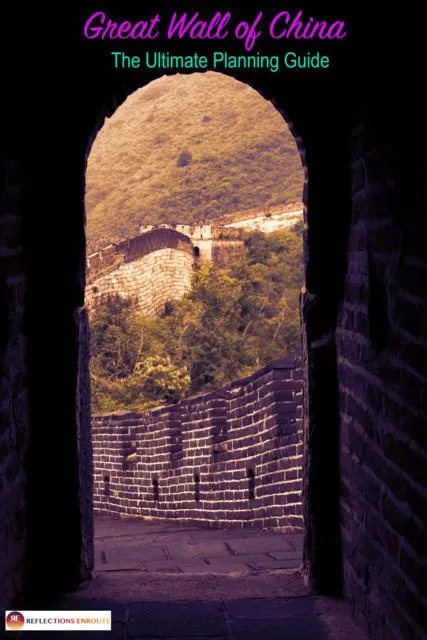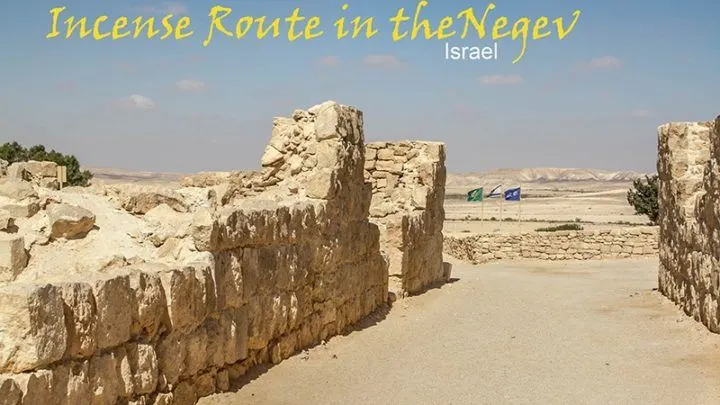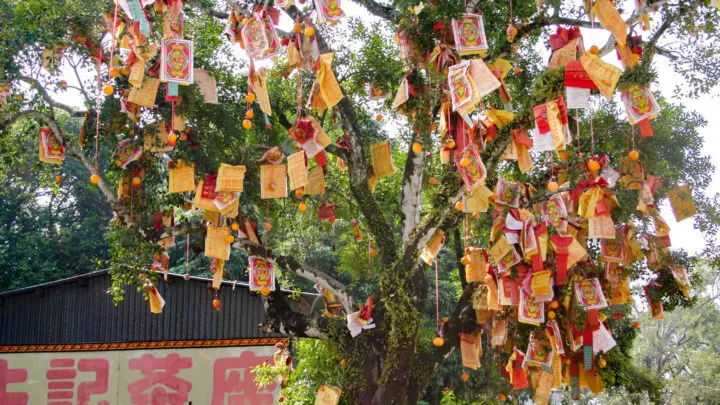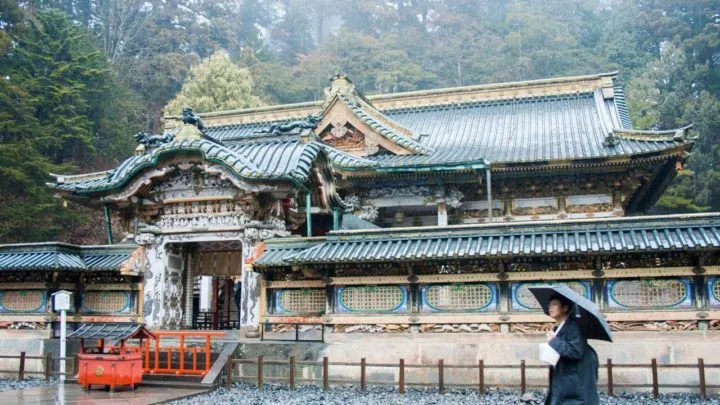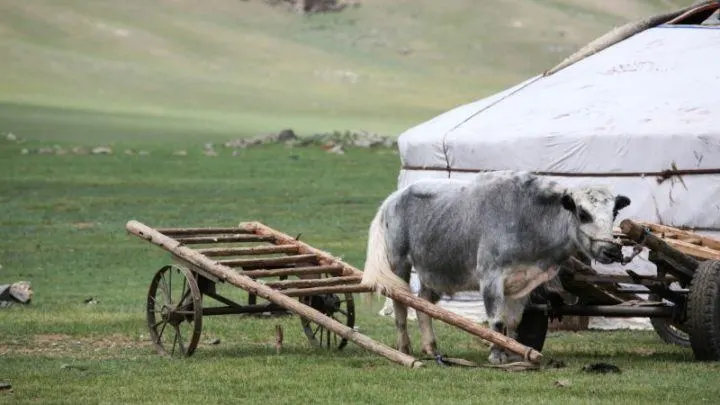Who wants to visit the Great Wall of China? You know you do! One of the most amazing sights and edifices in the entire world, the Great Wall is a must-do on your China trip.
Traveling around Asia, and especially China, especially to those special world heritage sites like the Forbidden Palace and the Terra Cotta Warriors, makes you feel like you are really traveling. Between the language barrier and the cultural differences, sometimes it’s a little intimidating. We know that if you go to China one of the things you want to do is see, climb, walk, and experience the Great Wall.
We’ve compiled this planning guide for you with the help of some great travel bloggers. You can download the Great Wall China Planning Guide Checklist, read our insights and tips, and feel comfortable heading out to one of the Seven Wonders of World.

Quick History of the Great Wall of China – When and Why Was it Built?
It was built because it was predicted that the Emperor of Qin would lose China to an invader. Many people thought the invaders were the Mongols, but it was any tribe from the north. Because of this threat, the wall was built to make an impenetrable fortress that was guarded with an important alarm system. Later, during the Han dynasty, the emperor extended the wall, because he wanted to protect trade on the Silk Road.
At the time, and for centuries after, it remained the largest military structure on the planet. Its cultural and architectural importance allowed it to be inscribed on the UNESCO World Heritage list in 1987. Because of this, there have been many more attempts at reconstruction and preservation of the various sites along the original wall, or walls.
When is the Best Time to Visit the Great Wall?
We’ve been to the wall both in summer and winter. We enjoyed it both times, but it was a completely different experience. It goes without saying that the majority of people visit the Great Wall during summer, high tourist time. I did.
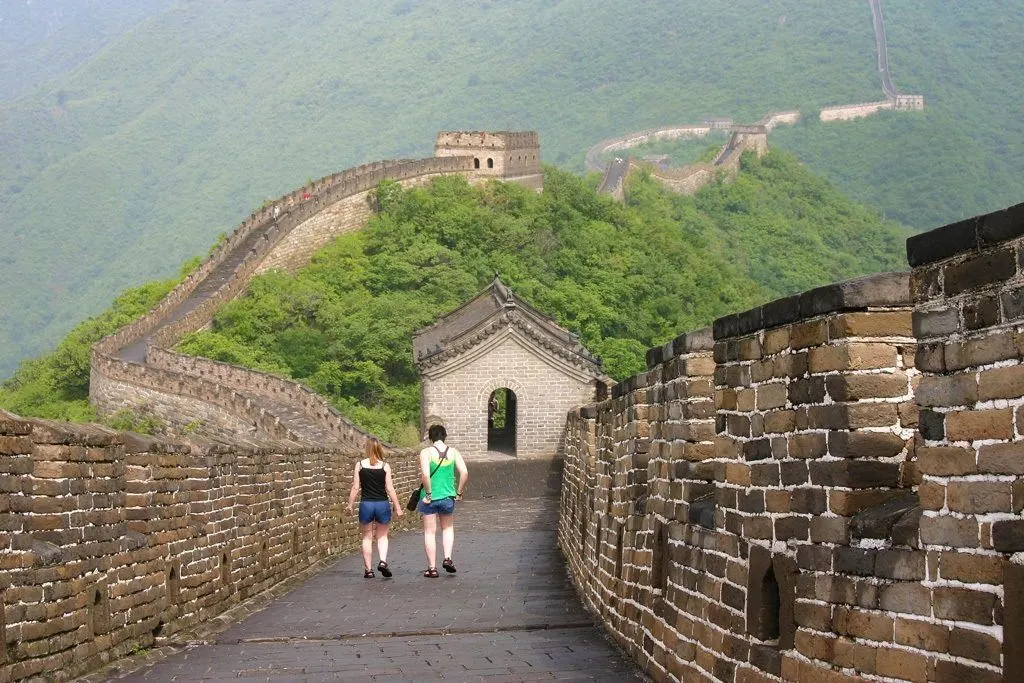
Summer is hot, humid, and crowded. We wore shorts, sandals, and tank tops, and we were still hot. We peeled off our sandals and walked barefoot on the Great Wall of China. Put that on your bucket list! We hired a car to take us, so we arrived early in the morning before the tour buses really started to arrive. We had about two hours wandering and climbing the wall around Mutianyu before it got too crowded and too hot. We were coming down before most people even started, and therefore the slide had no line at all.
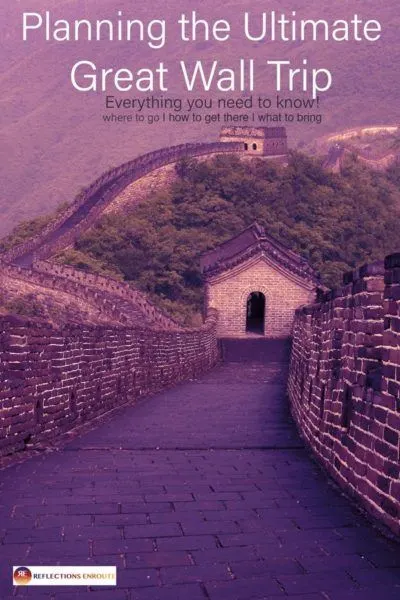
Winter was bitter cold. We also hired a car to take us that time and arrived early. The mist and fog was still out and there was hardly anyone around, no vendors and certainly no tourists. We only came across a Chinese visitor a couple of times. We loved just walking, and having it to ourselves, but the views were non-existent, and one of the things I love the most about the wall is seeing it wind around, up and down the mountains for as far as the eye could see.
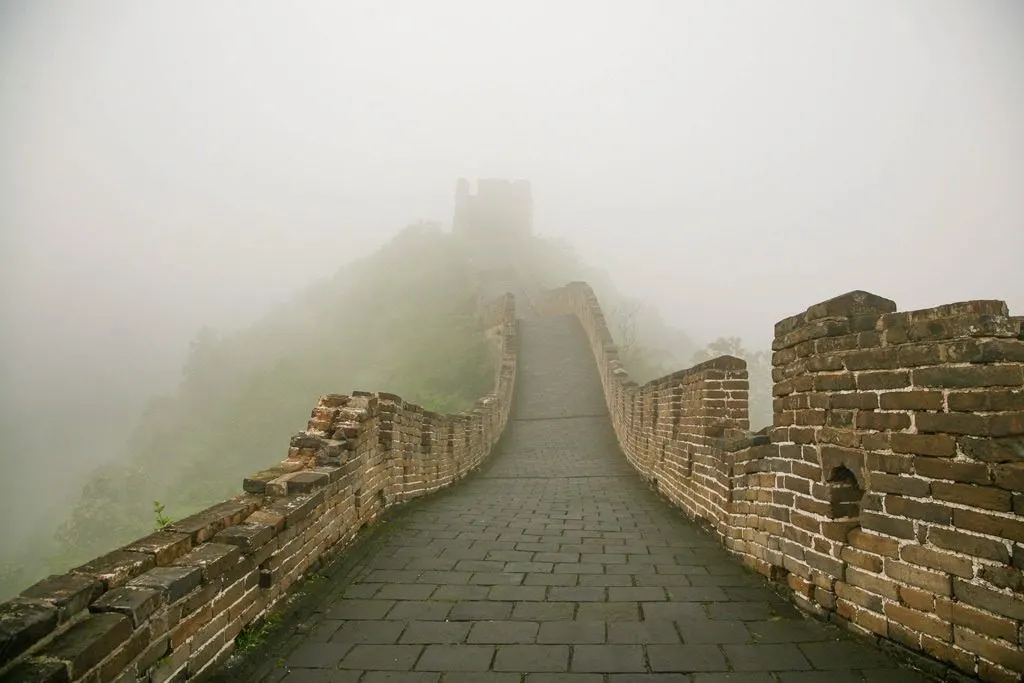
I imagine that spring and fall would be the best time of year to visit. Spring with its flowers, fall with its leaves; plus there naturally would not be quite as many tourists. However, no matter when you go, go early. I would even recommend staying at a hotel near whichever section you would like to visit so that you can get up early and get up to the wall before the masses.
Additional Reading: Chinese Megacities.
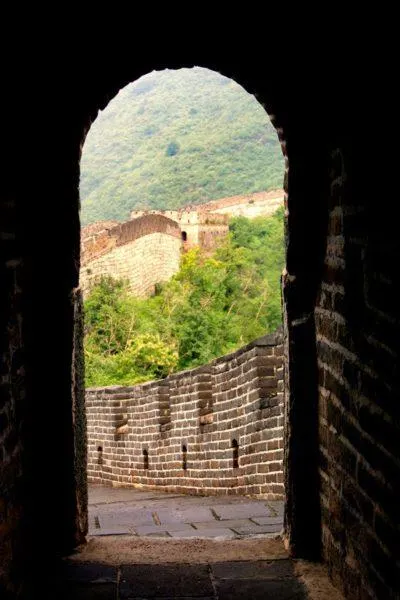
What Are the Best Sections of the Great Wall From Beijing?
The two most popular parts of the Great Wall most accessible from Beijing are Badaling, which is the closest, and Mutianyu. Because of its ease and proximity to Beijing, these two sites, over 10 million tourists visit them each year. It is unlikely that you would ever go when no one else is around, but no matter what the experience of walking the Great Wall is completely worth it.
Visiting the Mutianyu Section of the Great Wall
Both times I’ve visited, I headed to Mutianyu. The first time I was with my two teenage daughters and really just didn’t want to deal with crowds of people. We set up a private driver as soon as we checked into our hotel after arriving in Beijing since it was the number one thing we wanted to do in all of China.
We woke up at some unpleasant hour, got dressed and grabbed our Day Trip Essentials Kit, and headed downstairs. The car was already waiting for us and when we got into this black sedan with blue curtains, it just seemed somewhat comical. At that hour, there wasn’t much traffic on the roads, but hey with the many millions of people living in Beijing, there were still some.
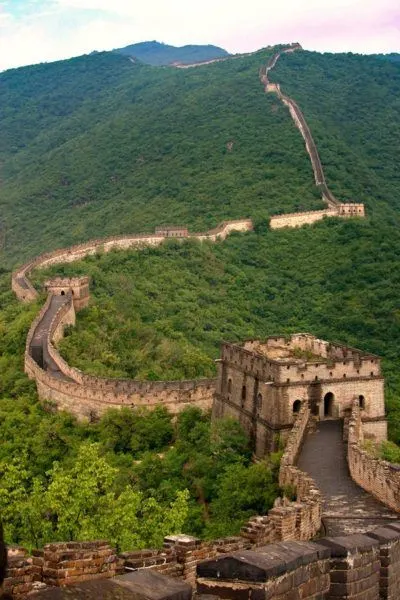
The drive took a couple of hours, but we were very comfortable. It was a bit overcast and rainy that morning, but it cleared up as we approached the Wall. As in many, many tourist areas, there is a gauntlet of vendors, but only about one-third were open, so we passed them by easily. We bought our tickets and headed up.
I don’t know what I thought about walking the Great Wall, or what it would be like, but to be honest I didn’t expect it to be as steep, windy, and as full of ups and downs as it was. I guess I just expected to climb up on it via a staircase and it would be flat, like a city wall. Boy, how wrong I was! Within minutes, we were panting and sweating. It’s a bit of a workout.
As I mentioned, it was early, and not many people were around yet so we hiked and hiked, stopped a lot to take pictures and get a little silly as you do with teenagers, and just had a great time. As the sun climbed, so did the numbers of people, exponentially, so we decided we’d had enough.
We wanted to find something to eat and maybe a souvenir. We were so excited to see the slide, toboggan run, was open and empty and we jumped right on. Not only was it an easy and fun way to descend, but the girls remember it as one of the highlights of the trip.
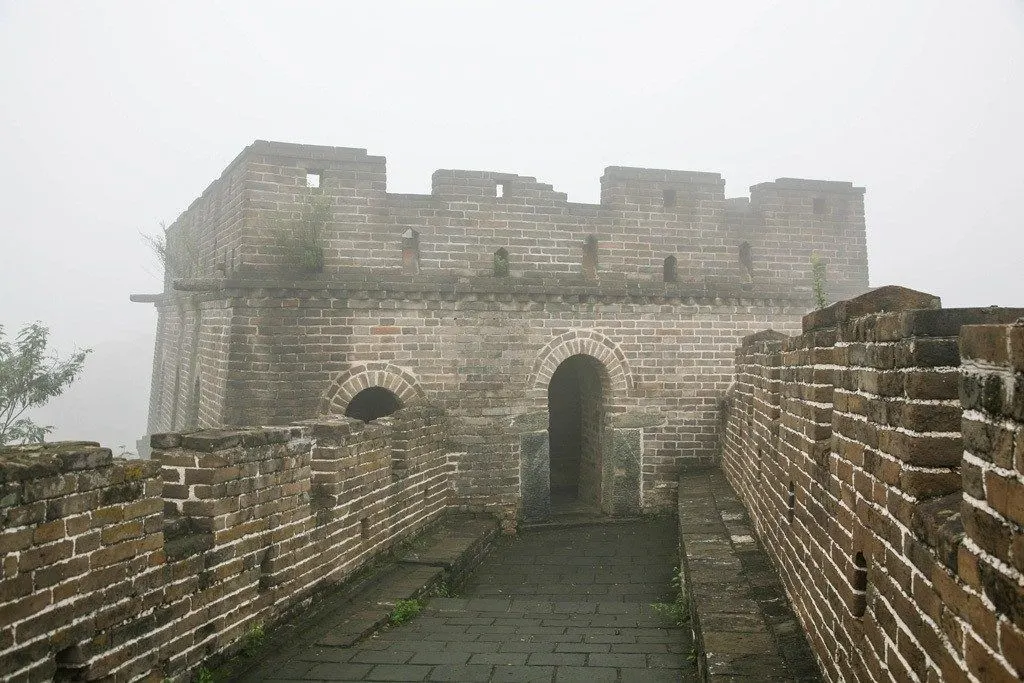
The second time I went to the Great Wall, I went just with Jim and tried talking him into going to Badaling, He would have nothing of it. He wanted to do Mutianyu as well. It was the end of November, and with the mist and lack of people it was austere, intimidating, and majestic; I know that if I were among a northern tribe thinking of invading, I certainly would have had second thoughts.
Since it was so cold, we really enjoyed the hiking that much more. Obviously the weather plays a huge role on whether you will enjoy your time or not.
Some other interesting bits on travel in China and the surrounding area are:
–China Travel Guide
–Xian Itinerary and the Terra Cotta Warriors
-Podcast: Travel to Volunteer with Animals – Saving Dogs from the Chinese Meat Market
–Taipei Itinerary
–Top Ten Things to do in Singapore
–Kuala Lumpur Itinerary
–Traveling to Japan – A Trip Planning Guide
To Get to Mutianyu from Beijing
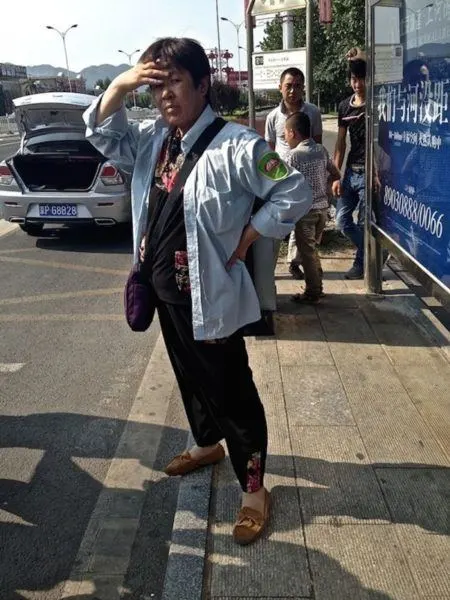
This next story is from our friend and travel blogger Stefan of Nomadic Boys.
Trekking the Great Wall of China was one of our most incredible memories from our travels. When we arrived in Beijing, this was, of course, top of our bucket list. We chose to visit the Mutianyu section of the Wall, which is further away and therefore less frequented by the hordes of tourists. It is located around 70km North East from Beijing and easy to reach on a day trip via a public bus from the city.
But, make sure you get the right bus (number 916) and ignore anyone who tells you otherwise…
When we tried to visit Mutianyu, there was little information online about getting there with the public bus, and the bus recommended by the (then) Lonely Planet stopped going all the way. There are people who dress up as bus officials (like the one in the photo) and try to get lost tourists (like us) to take the wrong bus (usually the 980) to the wrong place.
She comes with you, then at a certain spot she tells you you need to get off. Obviously you assume she’s right because she is wearing the official bus company badge. Then she tells you you need to take a special taxi for a very large cost to Mutianyu – a car with driver is of course there waiting.
We refused them and just took a private taxi split between us.
So you know, the correct bus to Mutianyu (and do not let anyone tell you otherwise – see below!) is the 916 from the main bus station. This costs around 11 yuan ($1.60) per person. It takes around 1 hour to the final stop. From there it’s a short minivan ride. There will be many of them waiting, and charge 10 yuan ($1.50) per person here. This last part of the journey takes around 20 minutes.
Other Articles Around Asia You Might Love
- Dalat, Vietnam
- Visting Vietnam
- Top 10 Singapore
- Our Trip to Java
- 2 Days in Kuala Lumpur
- Xian Itinerary, China
- The Great Wall of China
- Durin, a stinky fruit
- Top 10 Mongolia
- Jeju-Do, South Korea
- Angkor Wat, Cambodia
- Banaue Terraces, Philippines
- Elephant Orphanage in Sri Lanka
- 36 Hours in Brunei
- Hong Kong Wishing Tree Lady
- 3 Jewel Temples of South Korean
Visiting the Badaling Section of the Great Wall
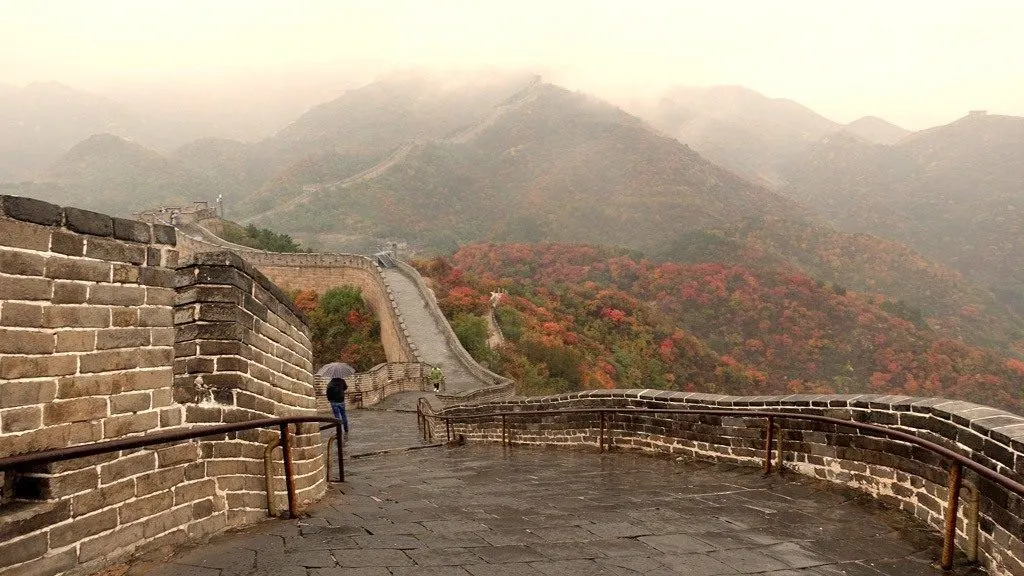
Melissa from Parenthood and Passports warns us not to let bad weather prevent you from visiting the Great Wall.
The weather often has a substantial impact on one’s first impression of a place or experience. If the weather is too cold, too hot, too rainy, or too icy it often fails to live up to expectations. But hiking the Great Wall of China in less-than-perfect weather can actually enhance the experience, as long as you are dressed appropriately for the elements. We visited the Badaling section of the Great Wall.
Badaling is the closest and easiest section to get to from Beijing. Because of that, it’s also the most crowded. However, we found the crowds seem to only come out when it is sunny or warm. On a rainy day, you will find it much easier to get those iconic photos of the Great Wall of China winding up the mountainside without a million other tourists crowding the walkway. We visited on a rainy, foggy, cold day in fall, which gave the world famous landmark a mystical beauty.
If you plan to visit the Great Wall of China in the rain there are a few things to keep in mind. The steep, uneven stone steps become incredibly slippery when they are wet. Wear rain boots or hiking boots, and if visiting the Great Wall of China with kids, watch them closely and make sure they hold onto the handrails when going up or down the stairs in the rain.
You can easily buy an inexpensive rain poncho from a vendor outside the gates at Badaling, if you don’t have one. And if you really want a photo of you on the Great Wall on a sunny day, just visit the visitor’s center on your way out where you can get a souvenir photo taken in front of a green screen for $5 US.
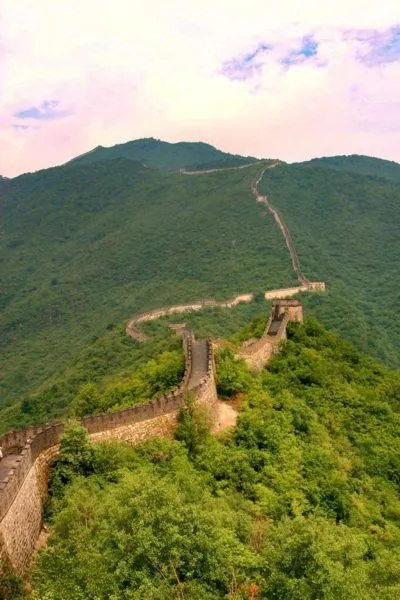
To Get to Badaling from Beijing
The easiest way to get to any part of the Great Wall is by tour or by hiring a private car. To drive to Badaling it’s about an hour and 30 minute drive mostly along route G7. Most hotels can call a private driver for you and set up the day. This is a good option, because your driver may not speak English, and by going through the hotel, you will know what your itinerary is before you go.
By Public Bus – From the Deshengmen Bus Terminal you have two options, bus 877 or bus 919. Both take almost two hours, but the 877 will get you closer, within walking distance where the 919 requires you to take the free shuttle to the entry point.
Visit the Jinshanling Section of the Great Wall
Nicky from Go Live Young tells us about her experience taking a guide to the lesser visited part of the Great Wall, Jinshanling.
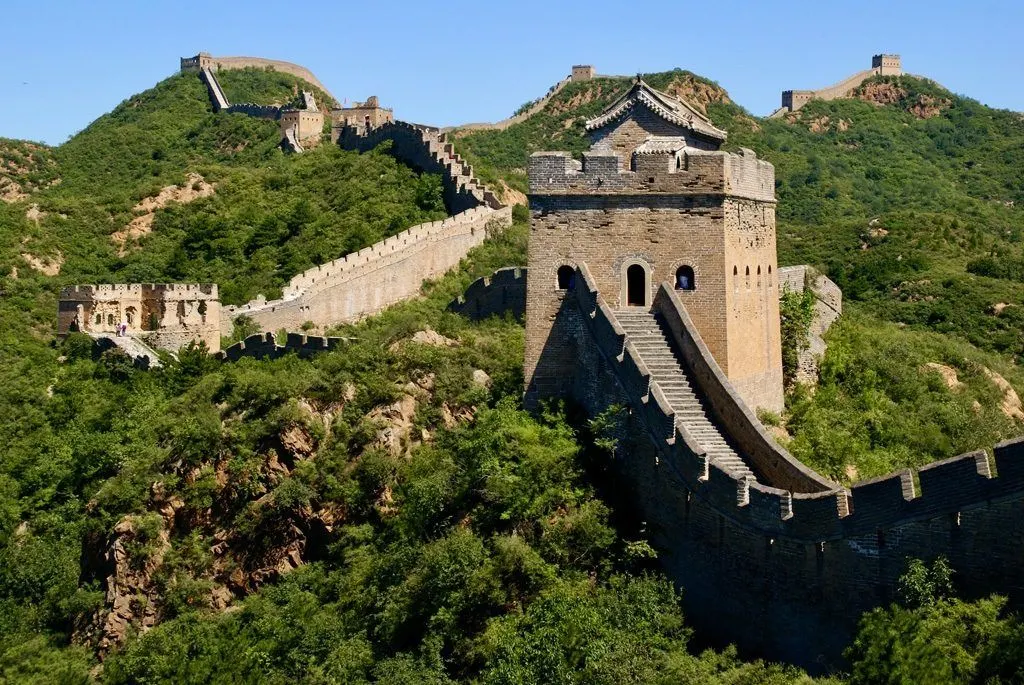
The Great Wall of China spans several thousands of kilometers. Some of the most accessible sections are found near Beijing. Badaling and Mutianyu are the easiest sections to reach and thus receive the largest amounts of visitors. Further out lie the unrestored sections of Jiankou, Jinshanling, Simatai and Huangyaguan. We chose to hike the Simatai West to Jinshanling section of the Great Wall as it gets fewer visitors, being further away from Beijing. This section offers amazing views of the Great Wall snaking across the mountain tops, many watchtowers, and hardly any people!
For the hike, we hired a guide using the company Great Wall Hiking. They organized transport to and from the wall as well as a private guide to look after us throughout the day. They run a variety of tours to the Great Wall, most of them to the unrestored, less visited sections. The service they provided was very professional and everything ran like clockwork.
The hike from Jinshanling to Simatai West is six kilometres and takes between three and three and a half hours. It is a two and a half hour drive out to the wall at this point, from Beijing.
We spent the most wonderful day hiking the Great Wall of China in summer and hardly saw anybody else! Our recommendation would be to hire a guide and get away from the crowds at the more visited parts of the wall closer to Beijing.
Jinshanling to Simitai – Wild to Tame
Sarah from A Social Nomad shares with us walking the wild Jinshanling.
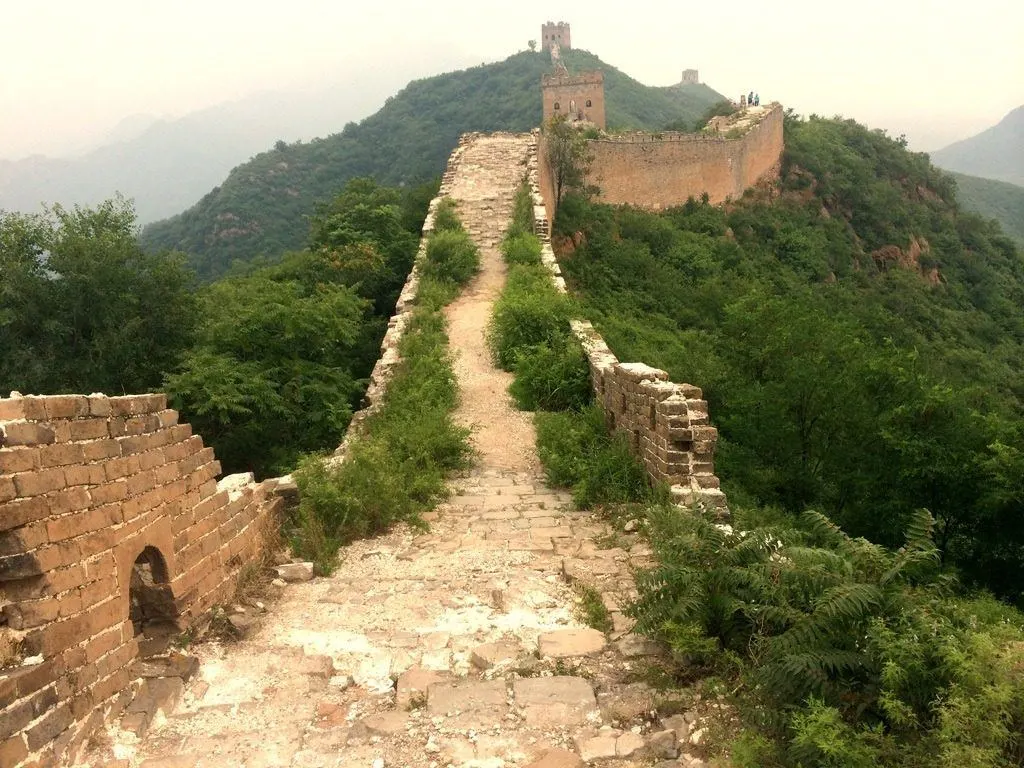
We decided to save a little money by not taking a tour of the Great Wall from Beijing. Our plan was to get to the Great Wall on public transport. And so we did, by chance meeting a local on the public bus taking two Western friends to the wall, offering for us to tag along. This meant, instead of wandering aimlessly, we got a great local tour, heading to the wild wall to the west of Jinshanling before walking back east to Simatai. We met few people, there were more hawkers trying to sell to us than other tourists.
There’s always someone trying to sell food and drink to you – but, of course, it all has to be walked up here, so at the least take water with you. There was even ice cream available There are souvenirs galore too, but remember, if you buy a book on the Great Wall you’re going to have to carry it all the way on your walk.
This trip for me was what the wall was about – the wild wall, where there wasn’t anyone competing for the photo space, where it was easy to imagine Chinese soldiers manning the wall to keep barbarian hordes out. It’s just a shame it wasn’t a clearer day for our outing!
Hiking from Jinshanling to Gubeikou
Laura of Two Stay Wild tells us about getting off the beaten track!
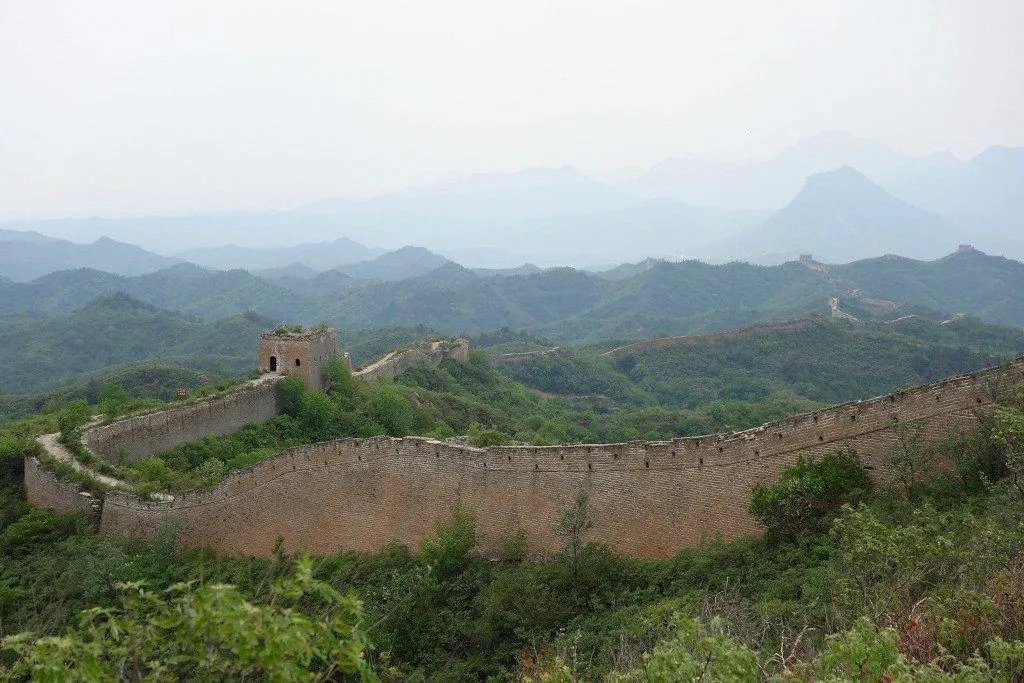
Getting an off the beaten track experience of the Great Wall of China isn’t as hard as it may seem. With a little bit of effort you can be strolling along the wall without a single person in sight. We didn’t see anyone for 3 hours when we completed this hike in June 2018.
For a day hike of moderate difficulty you can take in a lot of variations of the ancient wall. From the beautifully restored sections at Jinshanling to a scramble along the more wild sections, this 4-5 hour hike has many different sights to take in. Walking boots are definitely recommended, as there are parts with loose rock.
From the car park at Jinshanling, the wall can be reached by either a pleasant cable car ride over pine forest, or a not-too-strenuous uphill walk. Here you can see the wall in its original state – quite a site to behold, complete with watchtowers and defensive adaptations. The views of the wall snaking off into the distance are fantastic.
Setting off east, after about an hour the route leaves the wall to go around a militarised zone. This is a welcome change from the exposed wall, as it leads through quiet farmland and forest.
Arriving at the ‘wild’ section of the wall at Gubeikou, there is a real sense that nature has taken over. Trees and bushes sprout from the wall, and many of the towers are in ruins. On a clear day you can even see the spectacular mountainous Simatai section in the distance.
This is a highly rewarding walk, and has a real sense of traveling through history. We would thoroughly recommend doing it in the spring time, when the surrounding countryside is a verdant green.
To Get to Jinshanling from Beijing
Take the train to DongZhiMen, and from there you can take a free shuttle twice a day to Jinshanling. There are two there which leave around 7:30 and 8:20, and two back in the afternoon around 3:30 and 4:00. You won’t want to miss them.
Jiankou Section of the Great Wall
Eric of Once Upon a Backpack recounts his experience hiking the Great Wall
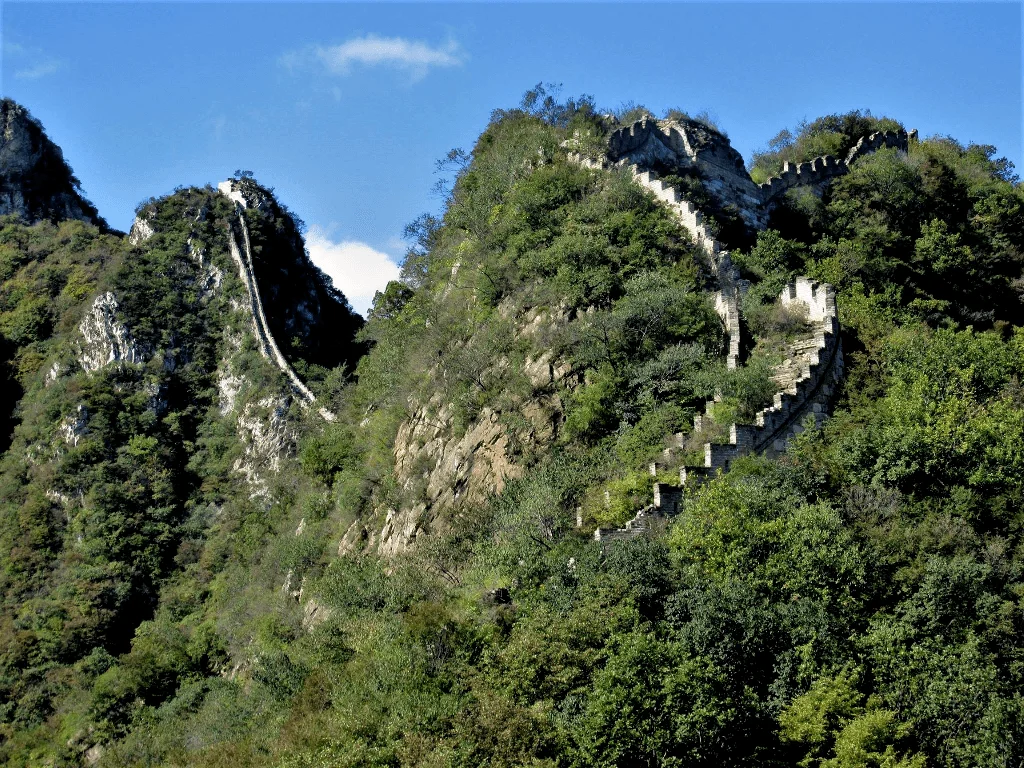
If you like your monuments old, crumbling, and forgotten in time, then the Jiankou section of the Great Wall is meant for you. While getting here and away is much more complicated than many of the other sections that are sprinkled around Beijing, those who make the effort to get here will be rewarded tenfold.
Jiankou is completely unrestored, the local white stone used in this section of the wall pops out among the mountain ridges and forest that has begun to grow on the top of the wall. After traveling China for more than four years, this has been my favorite place in China. Crowds are few, the scenery is breathtaking, and the wall itself will blow you away. The best season to visit is during the fall when the leaves burst into color and the sky is clearest.
The hike along the wall is both exhausting and exhilarating. Many sections leave you overlooking cliffs while one section rises so sharply, looking down may give you a bit of vertigo. Some sections of the wall are very dangerous and require you to dismount from the wall and hop back on later. Always play it safe and don’t push yourself to do anything that can get you hurt. While we were there, three people got trapped on a sheer drop section of the wall and had to be rescued.
How to Get to the Jinkou Section of the Great Wall
The only way to do Jiankou as a day trip from Beijing is to hire a taxi which will cost at least 700 RMB. For those with more time, there are plenty of guesthouses in the village located next to Jiankou. Staying out here overnight is an experience in itself. Waking up early to see the sunrise over the wall and the stargazing at night are well worth the time out here. Jiankou is the wall of your dreams, and the few that make it out here will have that dream come true.
Camping on the Great Wall Via Jiankou
Claire from Claire’s Footsteps tells us about her unusual, but exciting time at Jiankou.
Everyone talks about hiking on the Great Wall of China, but did you know you can camp on it too? I didn’t until I visited Beijing and found out about camping tours to China’s most famous attraction.
The tour takes two days and one night and involves hiking Jiankou, which is an unrestored section of the Great Wall, with no other tourists. Guests have the opportunity to camp inside a watchtower and if they’re lucky, see the sun rise over the wall in the morning.
We didn’t get a sunrise, but there was a huge thunderstorm. While it was a kind of scary experience – intensified by our guide’s stories about people being struck by lightning on the wall – it was the perfect camping on the Great Wall experience I could have imagined.
Some people report being able to camp on the wall independently. You’ll need a sense of adventure – and possibly a lack of fear about breaking a law in China (something that I know I wouldn’t want to do) – to do this though! Gubeikou seems to be the most popular option for this.
Whichever way you do it, camping on the Great Wall of China is an absolute must-do that should be on anyone’s China itinerary.
Is the Great Wall a Kid-Friendly Destination?
Now remember, I traveled with two teenagers to the Great Wall and they loved it. However, teenagers can walk and climb on their own. I wasn’t sure about little ones, but here are another couple of bloggers who agree…take those kids!
Leona of Wandermust Family gives us her take and tips on kids traveling to the Great Wall.
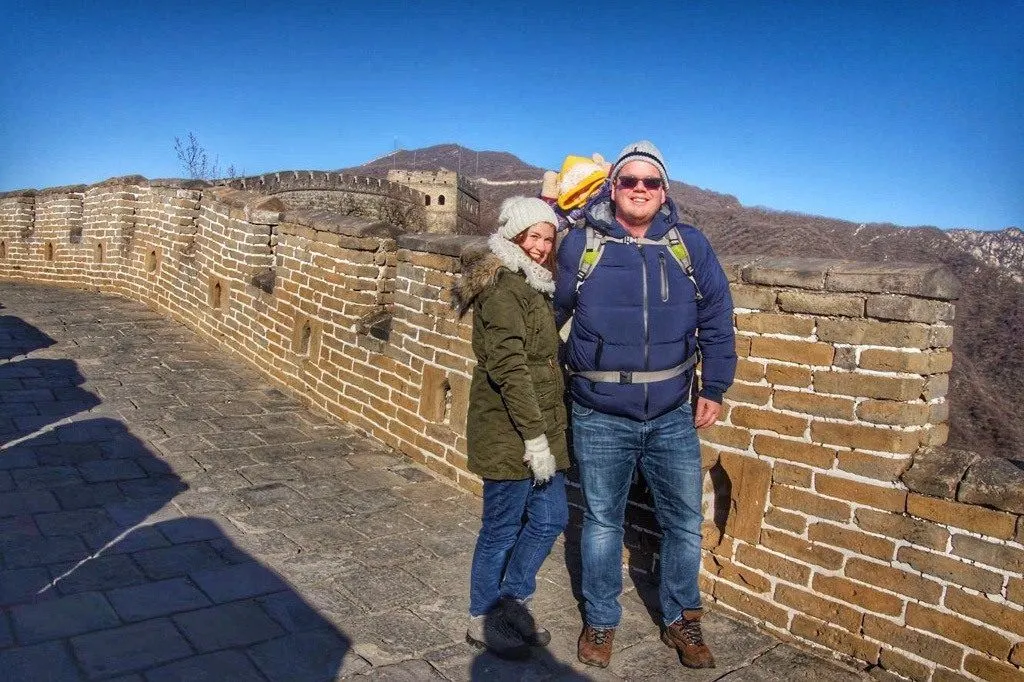
On the face of it the Great Wall of China might seem a strange choice to travel to with young children in tow! But we had a great time walking the Great Wall of China with our toddler when she was just under two! If you want to tick this bucket list item off your list with kids in tow then these are our top tips:
Pick the right section! We recommend doing it at Mutianyu section as it is one of the more accessible parts of the wall, is a relatively short distance from Beijing in Wall terms, is not as busy as other sections, and has many family friendly amenities such as the famous toboggan! It is vital, however, that you prepare for your trip well!
Some of the sections of the wall are steep and have uneven steps so I would recommend taking a carrier with you for some of the steeper sections. On top of that, it is vital that you pack plenty of snacks and a portable potty as amenities on the wall itself are obviously lacking so you need to make sure you have everything you need with you to spend a day or half a day on the Wall.
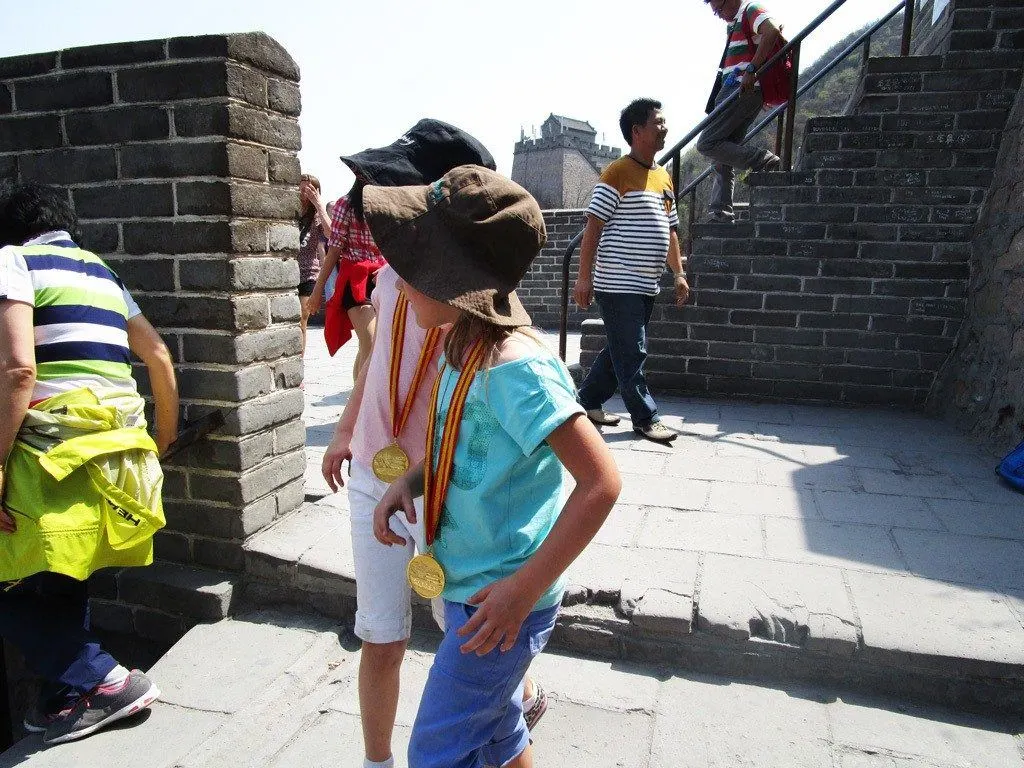
Barbara of Lets Go Mum not only took here kids, but they got medals for the visit!
A trip to the Great Wall of China with children is not complete without getting a gold medal as a reward for the climb!
We visited the JuYong Pass section of the Great Wall of China. This is a quite family-friendly section of the wall, but can also be very crowded on its lower sections. Locals and tourists alike climb the Wall here, with the crowds perhaps reaching their peak during the hot summer months. My two children were very eager and ready to make the climb – even though some of the steps were as high as their knees!
Within the hour we were at the topmost point, surveying the incredible vista laid out below us. We could see that we had climbed quite a steep section of the Great Wall of China! We really felt the need to celebrate as we skipped and ran our way back down, and so stopped in at a half-way stall to buy a unique Gold Medal for each of the children. Names can be engraved upon them there and then for the total sum of just $10 (USD).
The metal medals look very much like a full-sized Olympic medal! The looks of delight on the kid’s faces were absolutely priceless as they examined their personalized medals. They were beyond proud to have them hung around their necks – this was truly a souvenir to remember from one of the most memorable climbs of their life!
Can You Do The Great Wall on a Layover?
Danielle of Live in 10 Countries tells us how she did a layover and got to visit the Great Wall.
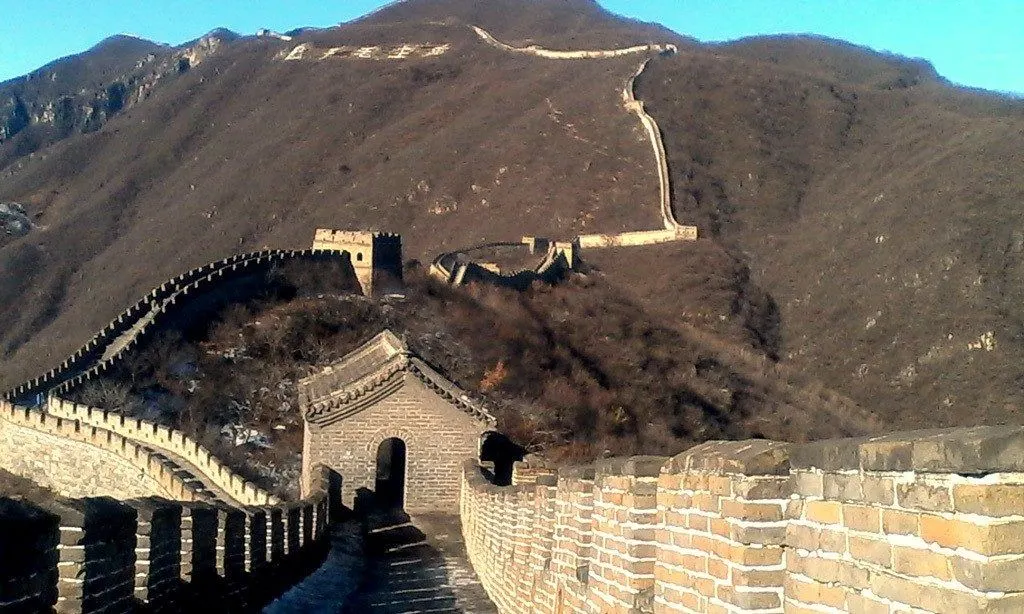
I organized a short layover in Beijing with the aim of trying the 72 hour visa free entry option, exploring a little of the culture and of course checking out the Great Wall at Mutianyu.
I was horribly underprepared, so please take my story as a ‘what not to do’. I assumed that big name credit cards like Visa and Amex would work in China, but that wasn’t the case. As soon as I landed, I realized I was in trouble as I didn’t have enough cash for my stay. Also my phone stopped working completely, even though it had roamed successfully in many other countries.
By pure luck, I was able to meet a fellow couchsurfer in Beijing central station and we decided to take the cheap route to the Great Wall, by going on local buses which passed near to the attraction, instead of a pricey tour bus. He lent me cash, too – the man is a saint. We hopped on the bus and drove for around 20 minutes.
That’s when my luck got worse. We stopped suddenly and two armed guards got on the bus. They said in English that we had to get off because the road was flooded and the bus couldn’t continue. They hustled all the foreigners off, but none of the Chinese people got up or reacted at all.
We were left on an isolated dirt road and the bus just continued on its journey. I didn’t see any evidence of flooding and I was really happy I had a friend, because it didn’t feel super safe once the bus left.
Rather conveniently, there were several taxis already waiting there in the road for us, quoting high prices for the rest of the trip. So, I did get to see the Wall, and it was as fabulous as you’d expect. But don’t try to go without paying tourist prices, it might just go very wrong.
Even if you can’t see the Great Wall from space, as we grew up expecting to be able to, I know that you will enjoy every minute of your visit.
Author Bio: Corinne Vail is a travel photographer, food lover, and a perpetual traveler who has been travel writing for over 14 years. For many years she lived overseas in Germany, Japan, Turkey, South Korea, and the Netherlands teaching the children of the US. military. She’s visited over 90 countries, and she’s not stopping anytime soon.
If you enjoyed the Great Wall...
